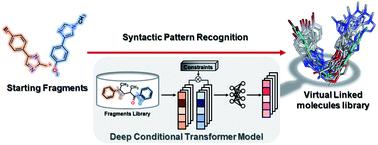当前位置:
X-MOL 学术
›
Chem. Sci.
›
论文详情
Our official English website, www.x-mol.net, welcomes your
feedback! (Note: you will need to create a separate account there.)
SyntaLinker: automatic fragment linking with deep conditional transformer neural networks
Chemical Science ( IF 7.6 ) Pub Date : 2020-07-22 , DOI: 10.1039/d0sc03126g Yuyao Yang 1, 2 , Shuangjia Zheng 1 , Shimin Su 1, 2 , Chao Zhao 1 , Jun Xu 1 , Hongming Chen 2
Chemical Science ( IF 7.6 ) Pub Date : 2020-07-22 , DOI: 10.1039/d0sc03126g Yuyao Yang 1, 2 , Shuangjia Zheng 1 , Shimin Su 1, 2 , Chao Zhao 1 , Jun Xu 1 , Hongming Chen 2
Affiliation

|
Linking fragments to generate a focused compound library for a specific drug target is one of the challenges in fragment-based drug design (FBDD). Hereby, we propose a new program named SyntaLinker, which is based on a syntactic pattern recognition approach using deep conditional transformer neural networks. This state-of-the-art transformer can link molecular fragments automatically by learning from the knowledge of structures in medicinal chemistry databases (e.g. ChEMBL database). Conventionally, linking molecular fragments was viewed as connecting substructures that were predefined by empirical rules. In SyntaLinker, however, the rules of linking fragments can be learned implicitly from known chemical structures by recognizing syntactic patterns embedded in SMILES notations. With deep conditional transformer neural networks, SyntaLinker can generate molecular structures based on a given pair of fragments and additional restrictions. Case studies have demonstrated the advantages and usefulness of SyntaLinker in FBDD.
中文翻译:

SyntaLinker:与深度条件变压器神经网络的自动片段链接
连接片段以生成针对特定药物靶点的集中化合物库是基于片段的药物设计 (FBDD) 的挑战之一。在此,我们提出了一个名为 SyntaLinker 的新程序,它基于使用深度条件变换器神经网络的句法模式识别方法。这种最先进的转换器可以通过学习药物化学数据库(例如ChEMBL 数据库)中的结构知识来自动连接分子片段。传统上,连接分子片段被视为连接由经验规则预先定义的子结构。然而,在 SyntaLinker 中,可以通过识别 SMILES 符号中嵌入的句法模式,从已知的化学结构中隐式学习连接片段的规则。借助深度条件变压器神经网络,SyntaLinker 可以根据给定的片段对和附加限制生成分子结构。案例研究证明了 SyntaLinker 在 FBDD 中的优势和实用性。
更新日期:2020-08-12
中文翻译:

SyntaLinker:与深度条件变压器神经网络的自动片段链接
连接片段以生成针对特定药物靶点的集中化合物库是基于片段的药物设计 (FBDD) 的挑战之一。在此,我们提出了一个名为 SyntaLinker 的新程序,它基于使用深度条件变换器神经网络的句法模式识别方法。这种最先进的转换器可以通过学习药物化学数据库(例如ChEMBL 数据库)中的结构知识来自动连接分子片段。传统上,连接分子片段被视为连接由经验规则预先定义的子结构。然而,在 SyntaLinker 中,可以通过识别 SMILES 符号中嵌入的句法模式,从已知的化学结构中隐式学习连接片段的规则。借助深度条件变压器神经网络,SyntaLinker 可以根据给定的片段对和附加限制生成分子结构。案例研究证明了 SyntaLinker 在 FBDD 中的优势和实用性。











































 京公网安备 11010802027423号
京公网安备 11010802027423号